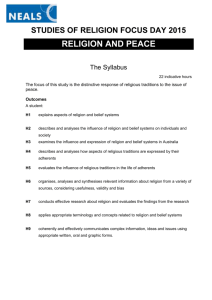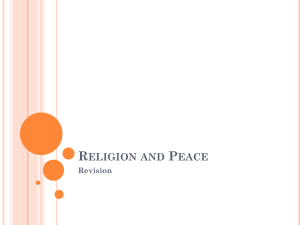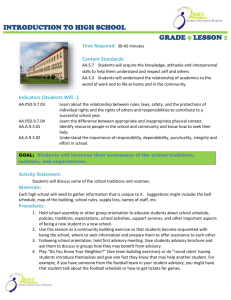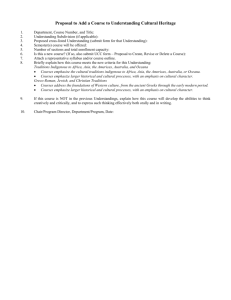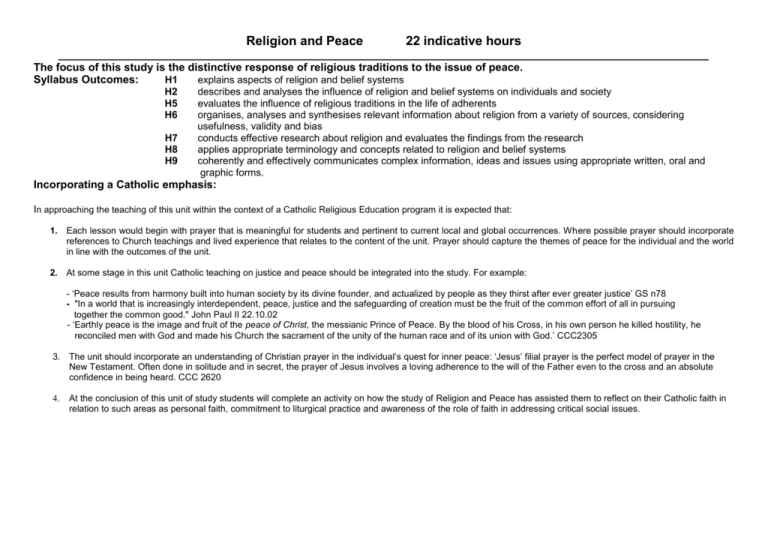
Religion and Peace
22 indicative hours
___________________________________________________________________________________________________________
The focus of this study is the distinctive response of religious traditions to the issue of peace.
Syllabus Outcomes:
H1
explains aspects of religion and belief systems
H2
H5
H6
H7
H8
H9
describes and analyses the influence of religion and belief systems on individuals and society
evaluates the influence of religious traditions in the life of adherents
organises, analyses and synthesises relevant information about religion from a variety of sources, considering
usefulness, validity and bias
conducts effective research about religion and evaluates the findings from the research
applies appropriate terminology and concepts related to religion and belief systems
coherently and effectively communicates complex information, ideas and issues using appropriate written, oral and
graphic forms.
Incorporating a Catholic emphasis:
In approaching the teaching of this unit within the context of a Catholic Religious Education program it is expected that:
1. Each lesson would begin with prayer that is meaningful for students and pertinent to current local and global occurrences. Where possible prayer should incorporate
references to Church teachings and lived experience that relates to the content of the unit. Prayer should capture the themes of peace for the individual and the world
in line with the outcomes of the unit.
2. At some stage in this unit Catholic teaching on justice and peace should be integrated into the study. For example:
- ‘Peace results from harmony built into human society by its divine founder, and actualized by people as they thirst after ever greater justice’ GS n78
- "In a world that is increasingly interdependent, peace, justice and the safeguarding of creation must be the fruit of the common effort of all in pursuing
together the common good." John Paul II 22.10.02
- ‘Earthly peace is the image and fruit of the peace of Christ, the messianic Prince of Peace. By the blood of his Cross, in his own person he killed hostility, he
reconciled men with God and made his Church the sacrament of the unity of the human race and of its union with God.’ CCC2305
3. The unit should incorporate an understanding of Christian prayer in the individual’s quest for inner peace: ‘Jesus’ filial prayer is the perfect model of prayer in the
New Testament. Often done in solitude and in secret, the prayer of Jesus involves a loving adherence to the will of the Father even to the cross and an absolute
confidence in being heard. CCC 2620
4.
At the conclusion of this unit of study students will complete an activity on how the study of Religion and Peace has assisted them to reflect on their Catholic faith in
relation to such areas as personal faith, commitment to liturgical practice and awareness of the role of faith in addressing critical social issues.
Students
about:
learn Students learn to:
NB: - Examples in this program are drawn predominantly from Christianity and Islam
- Some samples of material to support teaching and learning are provided at the conclusion
of this program and are identified as Sample 1, Sample 2 and so on.
The understanding of
peace in TWO religious
traditions
-
-
Suggested Teaching and Learning Strategies
peace expressed
through sacred texts
for TWO religious
traditions drawn
from:
Buddhism – Sutta
Pitaka,
Dhammapada
Christianity – the
New Testament
Hinduism –
Bhagavad Gita
Islam – Qur’an and
Hadith
Judaism – the
Prophetic vision of
peace on Earth
-
investigate the
understanding of peace
and how it is informed
through significant
writings within sacred
texts for TWO religious
traditions drawn from:
Buddhism – Sutta Pitaka,
Dhammapada
Christianity – the New
Testament
Hinduism – Bhagavad
Gita
Islam – Qur’an and
Hadith
Judaism - the Prophetic
vision of peace on Earth
1. Investigate the understanding of peace in TWO religious traditions:
a. Discerning an understanding of peace – class discussion on the concept of personal and
global peace. For example use stimulus such as:
Use Norman Rockwell’s The Golden Rule to initiate discussion of religions and peace
(Catholic Studies – To Know, Worship and Love p.220) + image link in bibliography
Quotations from various religious traditions relating to peace – see Sample 1
b. Forum: Personal and global peace in the 21st Century – the place of Religion?
NB: This question should be taken up again at the conclusion of the study to assess
development of understanding in relation to religion and peace.
c. For each of the two religious traditions chosen:
-
examine sacred texts that inform teachings on peace
Preliminary Link – Ethics See Sample 2
For examples of texts in Christianity and Islam see Sample 3
d. Writing task: Explain how sacred texts inform the understanding of peace in TWO religious
traditions. {NB students could do this as a pairs task each writing about ONE
religious tradition and then peer assessing the other response.]
2. The principal teachings about peace in two religious traditions:
principal teachings
about peace in TWO
religious traditions
outline the principal
teachings about
peace in TWO
religious traditions
a.
b.
In small groups students research a range of sources of teachings relating to peace in two
religious traditions. These should complement those from sacred texts.
Students present their findings to the class.
c.
Individually students create a summary outlining the principal teachings about peace in the
chosen religious traditions. This could be written or visual.
d.
Develop a dialogue between adherents of each of the religions being studied to explain the
principal teachings on peace to each other. Present in pairs and peer assess.
3. Guidance for individual peace in two religious traditions:
Preliminary Link: Review ‘Observance’ from the Religious Traditions chosen for study. For example,
‘personal prayer’ in Christianity and the Five Pillars in Islam – how do these assist adherents to achieve
inner peace?
the contribution
of TWO
religious
traditions to
peace in the
context of:
demonstrate how
TWO religious
traditions guide the
individual in
achieving inner
peace
– the individual
– means of
achieving
inner peace
a.
Students investigate the means available in two religious traditions of assisting the individual
to achieve inner peace
b.
See Chapters 3 and 12 of Catholic Studies - To Know, Worship and Love
c.
Students investigate case studies of individuals in two religious traditions who support
adherents in the quest for inner peace.
Class discussion of the above findings.
d.
e.
As a means of ‘demonstrating’ how religions assist the individual to achieve inner peace for
each of the religions studied students develop a table summary incorporating sacred texts,
principal beliefs. See Sample 4 for a draft template
f.
Writing task: With reference to specific examples, demonstrate how two religious traditions
assist their adherents to achieve inner peace. See Sample 5 for a ppt slide on how to
incorporate the components of the topic into a Band 5/6 response
4. The contribution of two religious traditions to world peace:
–
the world –
means of
achieving
world peace
discuss how TWO
religious traditions
are contributing to
world peace
a.
Present students with a range of teachings/statements from the two religions being studied
that indicate their stance on the issue of world peace. See Chapter 9 of Catholic Ethical
Thinking for Senior Secondary Students: ‘Global Peace, Development and Justice’.
b.
Students investigate particular case studies of how two religious traditions are contributing to
world peace. [It is suggested that contemporary issues be used for case studies]. See
Sample 6 for some examples.
c.
Class discussion of what can be learnt from the case studies. Do they match the media
portrayal of religious traditions in regard to world peace?
d.
Writing task: Discuss the contribution of two religious traditions to world peace. In your
answer incorporate relevant examples to illustrate how belief is translated into action.
NB It is suggested that the process of aligning sacred texts,/principal beliefs and
specific examples used for the study of personal peace be used to summarise
information and make connections between the components.
Review:
Return to the initial discussion question: ‘Does religion have a role in achieving personal and
global peace in the 21st Century?’
Observe student comments to ascertain how the study of ‘Religion and Peace’ has been
perceived by the class. Has there been any shift in opinion? Is so, what?
Writing task: Students complete individual written response to the discussion question.
Unit Reflection: How has the study of Religion and Peace assisted me to reflect on my own
faith and the support offered by my membership of the Catholic Church (or other for nonCatholic students)
Bibliography
Cardinal Arinze Religions for Peace, Dartmon, Longman and Todd, London, 2002 [This book has an excellent introduction on the meaning of
peace and provides explicit references to the sacred texts of religious traditions that exhort followers to the path of peace].
Engebretson, K et al Catholic Ethical Thinking for Senior Secondary Students, James Goold House Publications, Melbourne, 2004
Elliot, P.J. et al, Catholic Studies Years 11 and 12 To Know, Worship and Love James Goold House Publications, Melbourne, 2006
Morrissey, J. et al Living Religion 3rd Edition, Pearson Longman, Melbourne, 2005
Musser, D and Sutherland, D (eds) War or Words? Interreligious Dialogue as an Instrument of Peace Pilgrim Press, Cleveland, 2005
Internet
Norman Rockwell The Golden Rule http://www.learn-line.nrw.de/angebote/litweb_schreiben/The-Golden-Rule.jpg
World Conference of Religions for Peace http://www.wcrp.org/
The Centre for Peace and Conflict Studies – University of Sydney: http://www.arts.usyd.edu.au/centres/cpacs/index.shtml
The Sydney Peace Foundation: http://www.spf.arts.usyd.edu.au/index.shtml
Centre for Global Peace http://www.american.edu/academic.depts/acainst/cgp/index.html
The International Journal of Peace Studies http://www.gmu.edu/academic/ijps/
The Berkeley Centre for Religion, Peace and World Affairs http://irpp.georgetown.edu/
Prayers for peace from some of the world’s religious traditions provided by Harvard University:
http://www.hds.harvard.edu/oms/spiritual/peace.html
Message of Pope Benedict XVI for World Day of Peace January 1, 2006:
http://www.vatican.va/holy_father/benedict_xvi/messages/peace/documents/hf_ben-xvi_mes_20051213_xxxix-world-day-peace_en.html#_ftn2
Day of prayer for peace in the world – Assisi 2002 http://www.vatican.va/special/assisi_20020124_en.html
A Powerpoint presenting the authentic teaching on war and peace in Islam can be accessed at the following site. You may modify it for students:
http://www.princeton.edu/~rumi/files/warandpeace.ppt
INNER PEACE ISLAM http://www.islam-guide.com/ch2-3.htm
Australian Catholic Social Justice Council – excellent links to a range of teachings/issues:
http://www.socialjustice.catholic.org.au/CONTENT/socialteaching.html
Hadith relating to peace http://www.sufism.org/society/articles/PeaceHadith.htm
Sample 1
Some Thoughts on Peace from Religious Traditions
1. Prior to viewing the statements have the class develop a list of what they think the
major religious traditions say about peace.
2. Then view the statements below on overhead/powerpoint
3. Compare the two sets of information.
4. Use this as a basis for approaching the forum task: Does religion have a role in
achieving personal and global peace in the 21st Century?
Further texts from a range of religious traditions can be found at: http://www.unification.net/ws/theme074.htm
A range of peace quotes that would be useful discussion starters at: http://www.salsa.net/peace/quotes.html
Buddhism:
The First of the Five Precepts: ‘I abstain from harming all sentient beings’
Hatred is never appeased by hatred. Hatred is only appeased by love. This is the eternal law.
Pali Dhammapada v.5
Christianity:
‘Blessed are the peacemakers, for they will be called children of God’
Whoever claims to be in light
but hates his brother
is still in darkness.
Anyone who loves his brother
remains in light.
Whoever hates his brother
is walking about in darkness
not knowing where he is going,
because darkness has blinded him.
Matthew 5:9
1 John 2:10-11
Hinduism:
'This is the sum of duty: do naught unto others which would cause you pain if done to you.'
Mahabharata 5:1517
‘And when a man sees that the God in himself is the same God in all that is, he hurts not himself
by hurting others: then he goes indeed to the highest Path’
Bhagavad Gita 13:28
Islam:
‘And the servants of the Beneficent God are they who walk on the earth in humbleness, and when
the ignorant address them, they say, ‘Peace’
Qur’an 25:63
‘O you who have believed, why do you say what you do not do?
Great is hatred in the sight of Allah that you say what you do not do.’
Qur’an 61:2-3
Judaism:
‘Thou shalt not kill’
Exodus 20:13
‘The Lord has told you what is good. What is required of you is this: to do what is just, to show
constant love, and to live in humble fellowship with our God’
Micah 6:8
Sample 2
Consider how the ‘ethics’
ethics’ component can be
used to complement this understanding
Beatitudes,
Jesus’
Jesus’ Commandment of love
Islamic Jurisprudence
The Prophetic Vision
When you ‘investigate the understanding of peace and how it is informed through significant
writings within sacred texts for TWO religious traditions’ refer to the work done in the Preliminary
course on ethics. The foundations for teachings on peace will generally find their basis in the
ethical teachings of a religious tradition.
In conjunction with this the following article on ‘the golden rule’ (which would provide a useful link
to the Norman Rockwell image if it was used at the start of this unity) may be useful for
discussion:
Everyday ethics: Could golden rule bring world peace?
The golden rule isn't always as simple as it appears.
http://www.startribune.com/614/story/511333.html
Sample 3 Further examples from the sacred texts of Christianity and Islam
Christianity:
Source: http://iskandar.com/waleed911/peaceinthebible.html
Please note that only New Testament references as per the Syllabus have been included here.
Any references to Hebrew texts should be made in light of the usage in the New Testament, for
example, Jesus’ recitation of the Isaiah text in Luke 4.
"The fruit of the Spirit is love, joy, peace, patience, kindness, generosity, faithfulness, gentleness,
and self-control." - Galatians 5:22
"Blessed are the peacemakers, for they will be called children of God." - Matthew 5:9
"...be at peace with one another." - Mark 9:49
"Now the God of peace be with you all. " - Romans 15:33
"Grace be unto you, and peace, from God our Father, and from the Lord Jesus Christ."
1 Corinthians 1:3
"For God is not the author of confusion, but of peace, as in all churches of the saints."
1 Corinthians 14:33
"Grace be to you and peace from God the Father, and from our Lord Jesus Christ,"
Galatians 1:3
"And let the peace of God rule in your hearts, to which you are also called in one body; and be
you thankful." - Colossians 3:15
"Those things, which you have both learned, and received, and heard, and seen in me, do: and
the God of peace shall be with you." - Philippians 4:9
"Grace unto you, and peace, from God our Father and the Lord Jesus Christ."
2 Thessalonians 1:2
"Unto Timothy, my own son in the faith: Grace, mercy, and peace, from God our Father and Jesus
Christ our Lord." - 1 Timothy 1:2
"And the fruit of righteousness is sown in peace of them that make peace." James 3:18
"Grace and peace be multiplied unto you through the knowledge of God, and of Jesus our Lord,"
2 Peter 1:2
"Mercy unto you, and peace, and love, be multiplied." - Jude 1:2
Sample 3 cont. Islam:
Please note that this is a small selection of references to peace in the Qur’an. The full listing of 56
verses can be found at http://www.islamicity.com/QuranSearch/
Al-Baqara (The Cow) Baset - Hussari - Minshawi
2:224 AND DO NOT allow your oaths in the name of God to become an obstacle to virtue and Godconsciousness and the promotion of peace between men: [212] for God is all-hearing, all-knowing.
Al-Baqara (The Cow) Baset - Hussari - Minshawi
2:248 And their prophet said unto them: "Behold, it shall be a sign of his [rightful] dominion that you
will be granted a heart [239] endowed by your Sustainer with inner peace and with all that is enduring
in the angel-borne heritage left behind by the House of Moses and the House of Aaron. [240] Herein,
behold, there shall indeed be a sign for you if you are [truly] believers."
Al-Imran (The Family of Imran) Baset - Hussari - Minshawi
3:97 full of clear messages. [76] [It is] the place whereon Abraham once stood; and whoever enters it
finds inner peace. [77] Hence, pilgrimage unto the Temple is a duty owed to God by all people who are
able to undertake it. And as for those who deny the truth - verily, God does not stand in need of
anything in all the worlds.
An-Nisa (The Women) Baset - Hussari - Minshawi
4:83 AND IF any [secret] matter pertaining to peace or war comes within their ken, they [98] spread
it abroad - whereas, if they would but refer it unto the Apostle and unto those from among the
believers [99] who have been entrusted with authority, such of them as are engaged in obtaining
intelligence [100] would indeed know [what to do with] it And but for God's bounty towards you, and
His grace, all but a few of you would certainly have followed Satan.
An-Nisa (The Women) Baset - Hussari - Minshawi
4:86 But when you are greeted with a greeting [of peace], answer with an even better greeting, or
[at least] with the like thereof. [105] Verily, God keeps count indeed of all things.
An-Nisa (The Women) Baset - Hussari - Minshawi
4:90 unless it be such [of them] as have ties with people to whom you yourselves are bound by a
covenant, or such as come unto you because their hearts shrink from [the thought of] making war
either on you or on their own folk - although, if God had willed to make them stronger than you, they
would certainly have made war on you. [110] Thus, if they let you be, and do not make war on you,
and offer you peace, God does not allow you to harm them. [111]
Sample 4
A process to ‘demonstrate how TWO religious traditions guide the individual in achieving
inner peace’
For each religion studied students complete the following summary chart. This could be done in
pairs or small groups.
It is suggested that students have 3 - 4 examples from sacred texts as the foundation of this
study.
An example using Christian prayer as a means of achieving inner peace is included as a guide.
How religious tradition X provides guidance for the individual to achieve inner peace
Sacred Texts
Principal beliefs
Practical examples
Guidance for the
(specific texts relating to
(based on the specific
(of texts and teachings
individual
peace)
1
‘In the morning, while
it was still very dark,
he got up and went
out to a deserted
place, and there he
prayed.’
Matthew 6:6
2
3
4
sacred texts)
Catechism of the
Catholic Church:
- ‘The tradition of the
Church proposes to the
faithful certain rhythms
of praying intended to
nourish
continual
prayer…’
2698
- ‘The Christian tradition
comprises three major
expressions of the life
of prayer: vocal prayer,
meditation and
contemplative prayer.
They have in common
the recollection of the
heart.’
2721
translated to action)
The history of Centering
Prayer owes much to the
Trappist Monk, Thomas
Merton. In his writing he
said, "If you go to your
center you will find God
there."
Within Christianity there are
many groups who assist
individuals to develop their
ability to enter into
centering prayer (and other
forms of meditation). For
example:
http://www.christianmeditationaustralia.org/
Centering prayer is one
means by which the
Christian adherent may
follow the example of Jesus
and go to their own
‘deserted’ inner place to
encounter God.
Students may also be
interested to research the
suggested links between a
sustained prayer life and
mental and physical wellbeing
Sample 5
Demonstrate how TWO religious traditions
guide the individual in achieving inner peace
Sacred texts
Relationships
Teachings
Band
5/6
Impact on the
individual
Connections
Specific
Examples
of means/agencies/
models
An outstanding response to a question such as ‘Demonstrate how TWO religious traditions guide
the individual in achieving inner peace’ will incorporate all the elements of the unit. Students need
to draw on concrete examples of:
-
Sacred texts interpreted in
Teachings which are evidenced in
Specific examples/means of finding peace/role models/agencies/movements
which then provide guidance for and impact on
The individual
As in all areas of study students need to gain practice in ‘joining the dots’ or making connections
between the component of topics to maximise their potential marks.
Sample 6
Examples: Religion and World Peace
Seeds of Peace is an initiative of the National Council of Churches of Australia. The link below
goes directly to the downloadable files. Amongst these are individual case studies of Australians
working for peace in a wide variety of circumstances.
NB These materials would also be useful for investigating religion and inner peace. Go to:
http://www.ncca.org.au/special_projects/dov/seeds_of_peace/sop_files
The Columban Mission Institute (Australia)
Links to a range of peace-related issues ranging from the international impact of genetically
modified food on poor nations to a range of initiatives to foster Christian-Muslim dialogue in the
Australian context. http://www.columban.org.au/
Peace Churches
Students could investigate expressions of Christianity which expressly advocate pacifism, for
example the Society of Friends (Quakers) http://en.wikipedia.org/wiki/Peace_church
Religions for Peace – World Conference on Religion and Peace
Current examples of peace activism emanating from religious motivation.
http://www.wcrp.org/Rforp/RFP_1_MAIN.html
MidEast Web
Sacred texts and current initiatives for peace from the three Abrahamic traditions:
http://www.mideastweb.org/mewreligion.htm
Projects Working for Peace among Israelis and Arabs
Links to a wide range of such projects:
http://en.wikipedia.org/wiki/Projects_working_for_peace_among_Israelis_and_Arabs
The Parents Circle
A coalition of Jewish and Palestinian families who have lost immediate family members as a
consequence of war.
http://www.theparentscircle.org/
Pax Christi
An international Christian organisation working for peace in through a multitude of initiatives
http://www.paxchristi.net/

